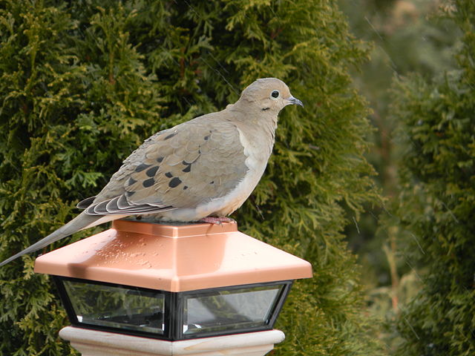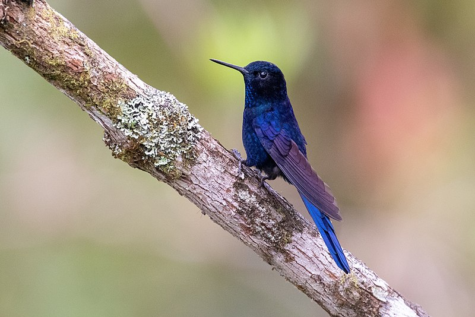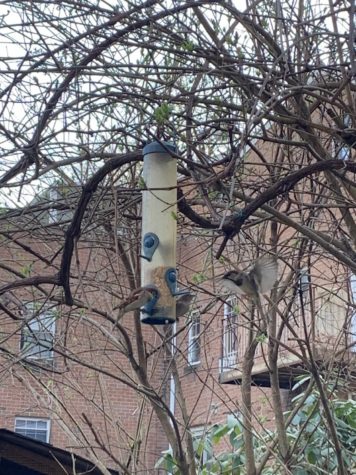What Declining Bird Populations Mean For Us
Many bird species are teetering on the edge of extinction, a symptom of a deep-rooted environmental crisis that we are currently facing.
Gary Leavens CC BY-SA 2.0
Red-winged Blackbirds, while still common in New York, have seen losses of roughly 90 million birds since the 1970s. As Ken Rosenberg from the Cornell Lab of Ornithology noted, “These bird losses are a strong signal that our human-altered landscapes are losing their ability to support birdlife.”
Pigeons perching on pipes, seagulls scrounging for scraps, finches flitting from tree to tree — though it may be easy to miss New York City’s lively bird population, the city is home to dozens of bird species, ranging from gulls and grosbeaks to woodpeckers and warblers. However, this diversity — both within the city and worldwide — is in jeopardy.
Bird populations across North America have plummeted, with nearly 3 billion birds vanishing from our skies — a 29% decrease since 1970. In fact, according to BirdLife International, 12% of bird species worldwide are at risk of extinction, with another 40% in decline.
Significant declines in avian populations prophesy discord in habitats worldwide; birds play crucial roles in scavenging organic waste, pollinating flowers, and spreading seeds. “All of our societies depend on these natural systems of insects, birds, and plants in multiple ecosystems across the earth,” Tod Winston, a researcher with the New York City Audubon Society (currently in the process of being renamed) told The New York Times.
Many birds are considered keystone species — a term coined in 1969 to describe species critical to the survival of an ecosystem — for their invaluable impacts on their environments. Woodpeckers, for instance, bore cavities into trees used by other species such as squirrels and bees. Similarly, predatory birds such as owls keep pest populations from exploding, which limits the spread of disease and the destruction of food stores by rodents. As Gabriella Zwiebel ’25 noted, without them, “there will be more rodents in cities because they aren’t being eaten by birds.” Losing these birds would cause ripples across their ecosystems, the effects of which other species might not survive.
Because avians are so inextricably tied to ecosystems, their populations have proven to be a reliable barometer of environmental health. Birds are some of the most well-documented species in terms of distribution and behavior since they are primarily active during the day and travel in clusters that are easy to notice and count. According to a global study conducted by BirdLife International, around half of all species monitoring programs revolve around birds.
Through these monitoring programs, researchers from the journal Science report that in North America, grassland bird populations — including many species of sparrows, larks, and ground birds — have declined roughly 53% since 1970. Likewise, shorebird populations have fallen 37% in the same time frame. Varieties of forest birds have also seen declines, with boreal forest birds — such as Great Horned Owls, Palm Warblers, and Rusty Blackbirds — seeing the steepest dip of 33%.
These losses not only impact local wildlife but also correspond with declines in human well-being. A 2021 study published in Ecological Economics reported that “the effect of bird species richness on life-satisfaction may be of similar magnitude to that of income.” This correlation can be explained by two main theories.
The first theory is simple — people generally appreciate seeing and hearing birds around them. A social survey conducted in the Chicago area revealed that residents most strongly agreed with the statements, “I value birds in my neighborhood because they are pleasing to the eye,” and “I value birds in my neighborhood because they are a part of this ecosystem.”
Another possibility is that people find areas where birds are prevalent more pleasant because environments capable of supporting many birds are generally healthier places to live — compared to dense urban locations, more rural areas tend to have better air quality and more biodiversity overall, which has been found to be beneficial to people’s mental health.
Regardless, it is evident that dips in bird populations worldwide paint a worrying picture, as steep downward trends in global avian populations indicate that the state of the environment has also deteriorated. “We all know when an animal species is in trouble, the entire food chain will be affected, and this will lead to other animal populations dropping as well, which will lead to the entire environment declining,” said Grace Lin ’23.
Climate change has severely impacted the lives of many birds; warming temperatures have contributed to a loss of habitat and resources. In New York Harbor, shorebirds like herons and egrets have become rarer due to rising sea levels submerging many of the small islands that the birds nest on. According to Dustin Partridge, director of conservation science for the New York City Audubon Society, there were only six active wading bird colonies in and around the harbor in 2023, the lowest it has ever been.
Shifting weather patterns have led to changes in migratory patterns of birds; species known for leaving New York during the winter months such as American Robins and Canadian Geese are able to remain farther north year-round because of milder winters. Black Vultures, which are traditionally found in South America, Central America, and the southern United States, have now been seen soaring over Midtown Manhattan and Staten Island, and they seem to be here to stay.
Such changes threaten the delicate balance within ecosystems; all it takes is one species appearing or disappearing from a particular habitat to disrupt the food web. Invasive species often outcompete native creatures for resources and cause damage to habitats.
However, while climate change continues to be a looming threat, it is far from the only one that birds face. According to the 2022 update of the State of the World’s Birds, the leading threats impacting the greatest number of threatened bird species are industrializing agriculture, logging, and hunting.
The industrialization of agriculture around the world has contributed to the destruction of many biologically diverse areas; as of 2018, a third of the planet’s land surface consisted of farms and other agricultural facilities.
Dr. David Williams, from Leeds’ School of Earth and Environment and the Sustainability Research Institute, said, “Our research suggests that without big changes to food systems, millions of square kilometers of natural habitats could be lost by 2050.”
Likewise, logging puts pressure on bird populations, destroying potential nesting sites and resources. Great losses in natural habitats force many species, not just birds, to the brink of extinction, and force the survivors to adapt by moving into new areas, where they may become invasive.
Exploitative human activities like hunting and trapping also pose significant threats. Birds are some of the most overexploited animals, with close to 30% of globally threatened birds in decline because of hunting and trapping. Many species, particularly pheasants, parrots, and pigeons, are hunted for food and sport, or prized for pet-trade.

The extinction of Passenger Pigeons in 1914 is one of the most well-known examples of humans hunting a species to extinction. Once, the birds were believed to have comprised 25 to 40% of the United States’ total bird population, with at least 3 billion passenger pigeons populating the country at the time Europeans discovered America; however, by the early 1900s, the wild population was all but gone. Because they were seen as “common” birds, their presence was taken for granted until it was too late.
A less well-known but equally tragic story is that of the Carolina Parakeet. The Carolina Parakeet was the only known parrot species native to the United States, and before settlers arrived, they thrived across the Central and Eastern regions of the country. For many years, researchers were unsure what drove the species to extinction — some claimed deforestation or disease — but a 2020 Current Biology study has led researchers to believe that human intervention was the true cause.
Kevin Burgio, an ecologist at the Cary Institute of Ecosystem Studies, told National Geographic, “It is largely agreed upon by those who study the Carolina Parakeet — myself included — that direct and indirect human activity led to the extinction of this species.” The parakeets were hunted to protect crops and for their vivid green and gold feathers, which often adorned ladies’ hats, until their eventual extinction in 1939.
The losses of the Passenger Pigeon and Carolina Parakeet serve as grim reminders of how easily humans can whisk common species to the brink of extinction; if no conservation efforts are made to preserve our wildlife, the same fate will befall many more creatures, spelling disaster for the global ecosystem.
Conservation is critical. Under ideal circumstances, designating specific, protected habitats will enable endangered species to re-establish their populations and foster balance within their ecosystems. However, the challenge comes with ensuring these areas remain protected.

The American Bird Conservancy (ABC), established in 1994, is an organization dedicated to preserving and restoring wild bird populations through partnerships with other conservation groups. Through collaboration with more than fifty partner organizations including the non-profits ECOAN and Fundación ProAves, the ABC has protected more than 1.6 million acres of bird habitat across fifteen countries in the Western Hemisphere.
For instance, they have designated a lush area in Peru called the Abra Patricia Reserve, which is one of the only places protecting the Long-whiskered Owlet, Ochre-fronted Antpitta, the Johnson’s Tody-Flycatcher, and the Royal Sunangel, four fairly new species first documented in the 1970s or later, are estimated to have fewer than 10,000 living adults in the wild.
However, in many aspects, conservation remains an uphill battle.
Last June, the United States was on track to pass the Recovering America’s Wildlife Act (RAWA), a massive environmental bill that would give states and territories up to $1.4 billion annually to fund wildlife action plans that address habitat loss, invasive species, emerging diseases, and reconnect disrupted migratory routes. RAWA also planned to invest in conservation led by tribal nations, whose lands serve as habitats for more than 500 threatened or endangered species.
The bill passed in the House of Representatives and was cleared by the Senate with bipartisan support — but ultimately, it was cut before the vote to pass it was called, primarily due to disagreements within Congress on how to pay for it.

We are in the midst of an environmental crisis. It is not simply an issue that affects a few birds or a few people; it affects everything, everyone, from finches in faraway forests to the folks down the hall, to ourselves.
Though the situation may seem daunting, it can only improve if we can acknowledge its gravity and address it.
While you may not have billions of dollars to fund conservation programs, there are other ways of supporting the environment — volunteering, spreading awareness, and making small lifestyle choices like recycling can go a long way.
If you’re particularly interested in helping our birds, setting out bird feeders or birdhouses can have a profound impact on the lives of local birds. The Cornell Lab of Ornithology has also compiled a short list of simple actions you can take to support birds, including keeping pets that may hunt birds indoors and installing screens on windows to keep birds from crashing into them.
Ultimately, no one person can solve our environmental dilemma. Much of the damage done is likely permanent — extinct species like the Passenger Pigeon and Carolina Parakeet will remain lost to time. However, we owe it to ourselves and the creatures around us to do our part in saving what we can.
Significant declines in avian populations prophesy discord in habitats worldwide; birds play crucial roles in scavenging organic waste, pollinating flowers, and spreading seeds. “All of our societies depend on these natural systems of insects, birds, and plants in multiple ecosystems across the earth,” Tod Winston, a researcher with the New York City Audubon Society (currently in the process of being renamed) told The New York Times.
Katrina Tablang is a Copy Chief for 'The Science Survey.' She enjoys journalistic writing because it enables her to explore a wide variety of perspectives...











